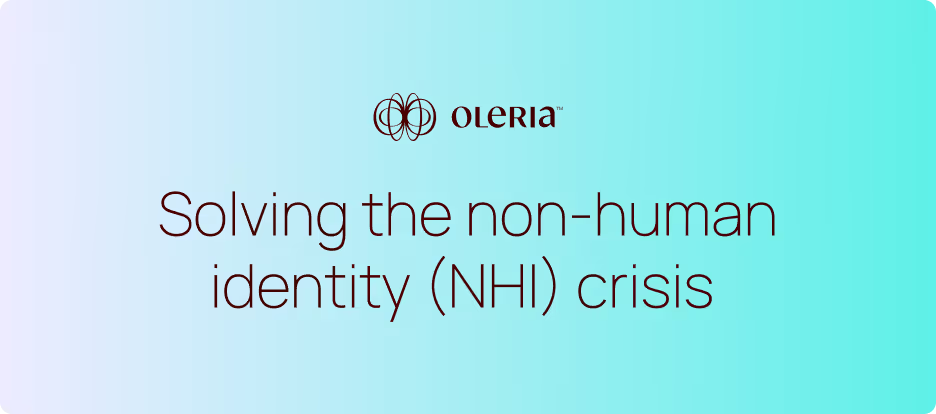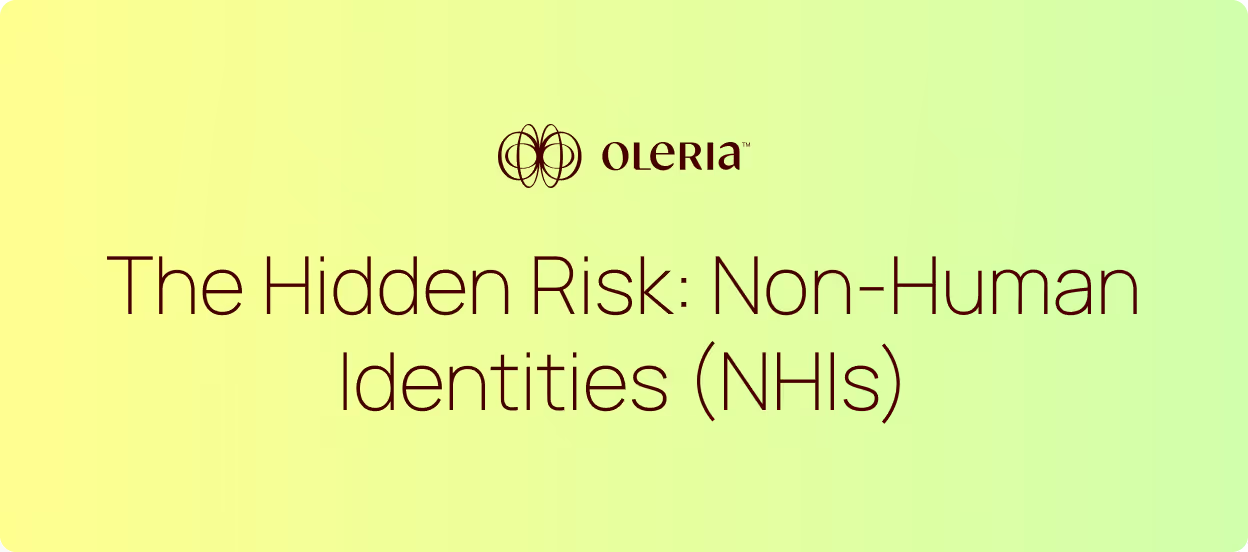Securing Non-Human Identities
The proliferation of non-human identities presents a tremendous blind spot in most organizations — and conventional tools can’t keep up.

By the numbers
NHIs outnumber humans by as much as 80:1
of breaches involve compromised identities
Average number of NHI-related security incidents per enterprise in the past year
of organizations ARE NOT highly confident they can prevent NHI attacks
Essential NHI Security Resources

Solving the non-human identity (NHI) crisis
Get best practices on how to eliminate NHI blind spots and manage NHIs effectively. Hear how leading security teams use a new breed of identity security tools (like Oleria) to gain the visibility and control needed to enforce least privilege and diligently govern NHIs.
.avif)
Secure non-human identities
A comprehensive guide for security leaders — from emerging NHI threats and their business-critical risks to how to build a modern identity security framework that covers all identities (human, non-human, and AI).

Securing your organization’s invisible workforce
Learn how NHIs are fundamentally reshaping the cybersecurity landscape and three key insights:
Why identity is now the key cyber risk entry point
How non-human identities (NHIs) became a huge blind spot
How agentic AI adds fuel to the NHI fire

The Hidden Risk: Non-Human Identities (NHIs)
See a visual breakdown of the NHI security landscape to visualize the risks, the root of the problem, and the three essential capabilities needed to secure machine identities.
NHI Security: FAQs
Non-human identities (NHIs) are machine-based accounts that access systems and resources without direct human interaction. These include service accounts, API keys, bots, applications, scripts, AI agents, OAuth tokens, servers, VMs, IoTs and secrets.
The fundamentally different nature of NHIs requires fundamentally different security approaches — including specialized tools, processes, and governance frameworks designed specifically for machine identities.
Visibility Gaps
Limited inventory capability: Most organizations cannot answer fundamental questions about which NHIs exist or who owns them, hindering security posture and NHI governance.
Unique complexities: NHIs span diverse technical implementations (machine accounts, API keys, AI models) each with distinct behaviors.
Rapid proliferation: NHIs vastly outnumber human identities, creating significant blind spots.
Complex lateral attack paths: Compromised human or NHIs enable lateral movements that are difficult to trace with traditional tools.
Governance Challenges
Lack of stewardship: NHIs often lack clear human ownership, making accountability and corrective action difficult.
Delegation without audit: NHIs perform tasks for humans without transparent audit trails.
Highly privileged by design: Many NHIs inherently operated with broad, privileged access to multiple resources.
Persistent credentials: NHIs often rely on hard-coded or long-lived credentials, creating hidden risks that are hard to detect, rotate, or manage.
Unlike human users, NHIs often operate 24/7, often with unintended privileges, making them attractive targets for attackers and a significant security blind spot.
Excessive permissions: NHIs often receive broad access because it's easier than implementing fine-grained controls
Dormant identities: Research shows approximately 40% of NHIs in most environments are unused but remain active
Persistent credentials: Hard-coded secrets in code or configurations create hidden, long-lived risks
Lack of stewardship: Many NHIs have no clear owner, making governance and lifecycle management impossible
No, traditional IAM tools struggle with NHI security because they were never built to manage and protect NHIs. In fact, research shows 56% of organizations find their current identity management tools insufficient for NHIs. Traditional tools struggle because of fundamental limitations:
Designed for humans: Built around human user patterns and lifecycle management
Limited in discovery: Can't comprehensively inventory NHIs across hybrid environments
Coarse-grained: Lack fine-grained permission management for diverse NHI types
Static governance: Don't account for dynamic, automated NHI operations
Lack of rapid remediation: Require complicated, time-consuming manual actions to address over-permissioning.
Organizations need purpose-built solutions or significant tool modernization to address NHI security properly.
Addressing the security gaps around NHIs is critical for Zero Trust success:
Never trust, always verify applies to machine identities operating 24/7
Continuous authentication must work for automated systems
Least privilege requires fine-grained controls for diverse NHI types
Monitor NHI behavior for compromise indicators
Traditional Zero Trust frameworks focused on human users must be extended to handle machine identities across cloud, SaaS, and on-premises environments.
NHIs create significant compliance gaps in most organizations:
Audit trails: Difficulty proving who authorized NHI actions
Access reviews: Traditional review processes don't work for machine identities
Data governance: Unclear data access and usage by automated systems
Regulatory requirements: Emerging regulations may require specific NHI controls
Documentation: Lack of clear ownership and purpose documentation
Proactive NHI governance helps address these compliance risks before they become violations.
As agentic AI evolves from simple query-based tools to autonomous agents, the business value increases—but so does the complexity of managing AI identities and access:
Query agents (read access): Offer read-only capabilities but carry risks of over-privileged and unattended access.
Task & workflow agents (write access): Can modify or delete data, introducing new challenges for access delegation and auditing.
Autonomous agents (approval access): Operate without human oversight, demanding automated approval mechanisms to ensure alignment with policies and regulations at machine speed
Start working on the governance foundations now in order to build autonomous identity management that can keep pace with autonomous AI systems:
Assess existing NHI health: Evaluate NHI health and remediate risks from over-privileged, dormant, or orphaned NHI accounts before leveraging AI agents
Establish delegation frameworks: Clear chains of responsibility for AI acting on behalf of humans
Implement automated approval: Systems that can make trusted decisions without human intervention
Modernize authentication: Move away from static secrets toward dynamic, short-lived credentials
Enable continuous monitoring: Real-time visibility into AI agent behavior and decisions
Govern intelligently: enforce least-privileged access at all time
NHI security will become increasingly critical as automation and AI proliferate. Trends include:
Explosive growth: NHIs will continue vastly outnumbering human identities
AI integration: Agentic AI will require new identity governance approaches
Regulatory evolution: Specific NHI security requirements will emerge
Tool specialization: Purpose-built NHI security solutions will become standard
Autonomous governance: Self-managing identity systems that adapt to changing conditions
Organizations that address NHI security proactively will have significant competitive advantages in an increasingly automated world.
.avif)
.svg)